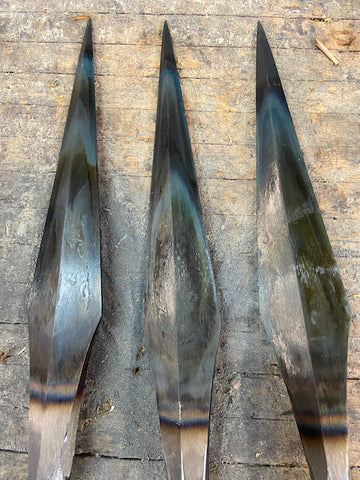Many medieval weapons were differentially hardened, which means that they were made of materials of varying hardenability and were heat treated in order make certain parts of the weapon harder than others. This is often the case with axes, hammers, and spears, and also with certain kinds of historical swords. In most cases the edges and impact surfaces are made to be harder than the other parts of the weapon. This is famously the case with some Japanese swords that have a soft core and and a hard edge, and some Viking period swords with similar properties.

Reinforced edge, differentially hardened Type L Danish War Axe
One way to create differential hardness is through a heat treatment process known as slack quenching in which a piece of carbon steel is heated to an appropriate temperature (usually red to yellow hot depending on the alloy), and is then quenched and withdrawn from the quench repeatedly. When you dip a red hot piece of steel into a cool quenching liquid, in the case of this video a bucket of canola oil, the thinner parts of the weapon will cool more rapidly than the thicker portions of the weapon.

Differentially hardened Hungarian Axe
A fast cool is what makes the hot steel become hard, but it can also become brittle. With a normal quench you usually quench the entire piece until it is cool, which makes the entire object hard. You then need to temper the steel by heating it back up to a temperature sufficient to partially relax the hard steel, which gives it springiness through the piece. When you slack quench you can skip the separate tempering step by allowing residual heat to remain in the thicker part of the item being hardened, which then warms the edge back up tempering it in a single process. One of the ways a smith evaluates how hard the piece is going to be is by watching the shifting colors of the quenched steel as the heat moves back to the edge. On the spearpoints in the video you can see the successive lines of blue and brown moving out from the center of the spear toward the edge. That blue color indicates that sufficient heat has migrated back out toward the edge to temper it.

Differentially hardened Celtic Spear
In the medieval period this process was used frequently for a variety of reasons, including the scarcity of hardenable steel and the fact that most tools simply did not need to be hard throughout. It also allowed a skilled smith to use his senses to figure out when the tool was appropriately hard rather than turning an electric kiln up to 450 degrees and setting a clock for two hours, which is how such things are often done today.

Note the bands of color indicating how heat moved out toward the edge during slack quench
Check out the video for some awesome red hot metal and flaming quenches.

Nathan Clough, Ph.D. is Vice President of Arms and Armor and a member of the governing board of The Oakeshott Institute. He is a historical martial artist and a former university professor of cultural geography. He has given presentations on historical arms at events including Longpoint and Combatcon, and presented scholarly papers at, among others, The International Congress on Medieval Studies.
Craig Johnson is the Production Manager of Arms and Armor and Secretary of The Oakeshott Institute. He has taught and published on the history of arms, armor and western martial arts for over 30 years. He has lectured at several schools and Universities, WMAW, HEMAC, 4W, and ICMS at Kalamazoo. His experiences include iron smelting, jousting, theatrical combat instruction and choreography, historical research, European martial arts and crafting weapons and armor since 1985
